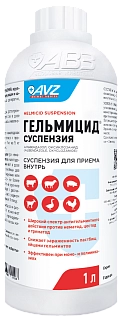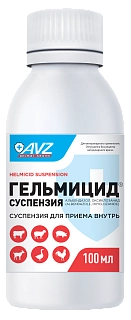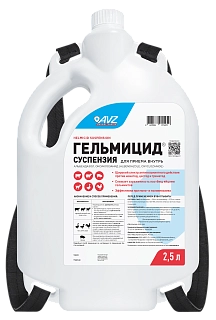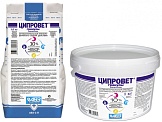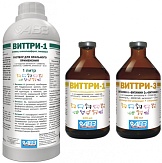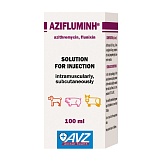HELMICID SUSPENSION
Benefits:
- Broad action spectrum
- High efficacy.
- High safety.
- Reduction of pasture contamination.
- Easy to use.
Composition and pharmacological properties.
1 ml of drug contain 50 mg of albendazole and 37.5 mg of oxyclozanide as active ingredients, and Tween-80, nipagin, nipazole, lactose and purified water as excipients.
The combination of albendazole and oxyclozanide in the drug provides a broad anthelmintic effect of the drug against nematodes, cestodes and trematodes.
Albendazole is effective in mono- and multiple-invasive diseases caused by imago and larvae of nematodes and cestodes, as well as imago trematodes. Due to the oocidal effect, it reduces the infection burden in pastures with helminth eggs.
The mechanism of action of albendazole is based on the selective suppression of polymerization of beta-tubulin leading to the destruction of cytoplasmic microchannels of cells of the intestinal tract of helminths; by changing the course of biochemical processes, albendazole suppresses glucose utilization and inhibits ATP synthesis, blocks the transport of secretory granules and other organelles in the muscle cells of helminths, causing their death.
Oxyclozanide has a strong trematodocidal effect on the larval and mature forms of trematodes parasitizing in ruminants and pigs, including Fasciola spp., Paramphistomum spp., Dicrocoelium lanceatum, as well as Echinostoma revolutum, Prosthogonimus ovatus parasitizing in poultry.
The mechanism of action of oxyclozanide is based on a violation of the phosphorylation processes in helminths, a decrease in the activity of fumarate reductase and succinate dehydrogenase, which leads to paralysis and death of trematodes.
After oral administration of the drug product, albendazole and oxyclozanide are rapidly absorbed in the gastrointestinal tract and penetrate into organs and tissues; they are excreted from the animal body mainly with urine and partially with feces in unchanged form and in the form of metabolites.
Indications
The drug is used for dehelminthization in cattle, sheep and goats with trematodosis (fasciolosis, dicroceliosis, eurythrematosis, paramphistomidosis), intestinal nematodosis (hemonchosis, bunostomosis, esophagostomosis, nematodirosis, habertiosis, cooperiosis, strongyloidosis, trichostrongylosis, trichocephalosis, neoascariasis) and pulmonary nematodosis (dictyocaulosis, protostrongylosis, mulleriosis, cystocaulosis), cestodosis (monesiosis, avitellinosis, tizanesiosis); in pigs with nematodes (ascariasis, esophagostomosis, metastrongylosis, trichocephalosis, strongyloidosis) and fascioliasis; chickens, geese and ducks with nematodosis (ganguleterakidosis, ascariasis, heterakidosis), trematodosis (echinostomatidosis, prostogonimosis) and cestodosis (drepanidoteniosis, hymenolepidosis, rayetinosis).
Contraindications.
Do not administer the drug to males and females during the mating period, to sheep, goats and sows in the first half of pregnancy and heifers in the first 1/3 of pregnancy. If necessary, the drug can be administered to breastfeeding females and young animals according to the veterinarian's prescription if the expected benefit outweigh the potential risk.
Posology and method of administration
The drug is administered to cattle, sheep and goats individually orally at following single doses:
- in trematodosis, protostrongylosis and ostertagiosis – 1.25 ml per 5 kg of animal bodyweight; - in cestodosis and nematodosis (excluding ostertagiosis and protostrongylosis) - 1 ml per 5 kg of animal bodyweight.
In pigs with nematodosis and fascioliasis, the drug is administered orally once individually at a dose of 1 ml per 5 kg of animal bodyweight.
In geese, ducks and chickens with nematodosis, cestodosis and trematodosis, the drug is administered at a dose of 1 ml per 5 kg of poultry bodyweight for two consecutive days individually or in groups (not more than 100 pcs) with food during the morning feeding. The drug at the estimated dose is mixed with feed at a ratio of 50 g of feed per 1 bird. Thoroughly shake the suspension before use.
Before mass dehelmintization, each batch of the drug is pre-tested in a small group of animals (5-10 heads). In the absence of complications, the entire livestock is treated within 3 days.
Side effects.
When Helmicid® suspension is used in accordance with this instructions, the risk of side effects and complications is low. In increased individual sensitivity to the components of the drug, individual reactions are possible (depression, hypersalivation, diarrhea), which resolve spontaneously without drug therapy.
Special warnings.
Slaughter of cattle, sheep, goats and pigs for meat is allowed not less than 20 days, poultry - not less than 5 days after dehelminthization. Milk from dairy animals can be used for food purposes not less than 4 days after dehelminthization. Meat and milk obtained before the expiration of the specified time limits can be used as food for fur-bearing animals.
Storage.
Store in a closed original package, protected from direct sunlight, at 2°C to 25°C. Shelf life when stored in accordance with instructions is 2 years from the date of manufacture, in-use shelf-life is 3 months.






